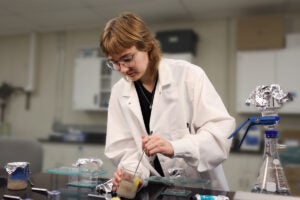As part of a broad international effort to eliminate the testing of nuclear weapons, engineers at The University of Texas at Austin were awarded $511,000 from the U.S. Department of Energy’s National Nuclear Security Administration to research better methods for monitoring and detecting covert nuclear tests.
Associate Professor Steven Biegalski and Assistant Professor Mark Deinert, both of the Nuclear and Radiation Engineering Program, will work on how atmospheric xenon can be used to determine whether a country has conducted a nuclear test. Nuclear tests, they say, are typically tested below ground to keep the radioactive products out of the biosphere and to conceal tests from regulatory agencies.
To detect clandestine tests, the world community relies, in part, on atmospheric monitoring for xenon, an inert gas that is difficult to contain in a facility or underground. When a radioxenon signal is observed, it is examined to see if it matches the profile of a nuclear explosion.
Biegalski’s and Deinert’s work will lead to further understanding of the transport of radioxenon in underground systems and will explore how the diffusion of xenon from a site can affect its signature and possibly skew the international community’s ability to determine if a nuclear test has occurred.
Radioxenon was the only radioactive element reported to have been measured in the atmosphere after nuclear weapons tests two years ago in North Korea.
“The test was conducted underground and xenon appears to be the only material that escaped in measurable quantities,” Biegalski said. “This supports the notion that radioxenon monitoring is important to monitor for nuclear-weapons testing in other countries, which is vital to global nuclear non-proliferation efforts.”
Biegalski and Deinert will also study the emissions of radioxenon from commercial nuclear reactors and medical radionuclide production facilities in order to differentiate those source types from a nuclear detonation. Work under this grant will begin in early 2009 and continue for three years.
Learn more about the Nuclear and Radiation Engineering Program. A high-resolution photo of Biegalski is online.



